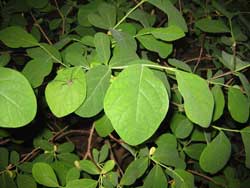Resource Library
Plant of the Week: Leatherwood
The University of Arkansas System Division of Agriculture does not promote, support or recommend plants featured in "Plant of the Week." Please consult your local Extension office for plants suitable for your region.
Plant of the Week
Leatherwood
Latin: Dirca palustris

At a recent crafts fair, I purchased a handmade "berry basket" - a peeled eastern red cedar bark basket laced together with the tough cordage made from leatherwood, Dirca palustris. The basket went into my curio corner, where I accumulate such interesting pieces of natural handiwork. Visiting with the crafter about the process she used to construct the basket, our conversation drifted to leatherwood. Therein lies a tale.
Leatherwood is a small deciduous, low-branched shrub of the Thymelaeaceae family, a largely tropical family containing more familiar garden plants such as Daphne and Edgeworthia. Shrubs are usually 3 to 6 feet tall with a similar spread. Leaves are alternate, 1 to 3 inches long with an entire margin. The summertime green of the leaves is a distinctive shade of gray-green, with fall color often a clear yellow.
The small, paired, pale yellow flowers are to one-third of an inch long, and appear terminally and at nodes along the stem in early spring before leaves appear. Though not especially showy, they are interesting by virtue of being produced when few other shrubs are in bloom. The fruit is a pale reddish fleshy fruit containing a single large seed, which ripens in midsummer.
My conversation with Karen Ament, the artisan from Kingston, Ark., who made the berry basket, led to her telling me about how the old-timers in this part of the southern Ozarks used leatherwood bark as cordage and in basketry. American Indians before them also used the surprisingly strong and supple material, sometimes even using it for bowstrings.
Karen related that usually she found leatherwood growing along streams in cool, shaded locations (the Latin name palustris means "grows in marshy areas"). However, in a recent brush cleanup around her house, she was surprised to find leatherwood growing near her home, atop a hill.
As it turns out, Karen had discovered near her home a newly described species of leatherwood, D. decipiens (A. J. Floden et al, 2009). This species has the same general look of the more widely distributed D. palustris but differs in three major ways: 1) it occurs on drier, often more alkaline upland sites; 2) it has sessile flowers, whereas D. palustris produces blooms on a short peduncle that protrudes out of the involcural bract; and 3) the leaves of D. palustris are usually glaberous, whereas the newly described species is uniformly pubescent. So far, this species has only been found in scattered locations in the western Ozarks in Kansas, Arkansas and Missouri. If confirmed, Karen’s plant would be a new county of record in Arkansas.
DNA testing further confirmed the difference between the two look-alike eastern species of Dirca and the two also similar western species, D. mexicana and D. occidentalis. The DNA analysis proved that the newly identified D. decipiens (which translates as "deceptive") has a closer affinity to the two Western species than the more common eastern leatherwood.
It is postulated that all Dirca species are relics of a cooler, wetter period during the Eocene 55 to 34 million years ago. With the uplift of the Rocky Mountains, the western states and the middle part of the country became drier, and the leatherwood populations began shrinking. Over time, the once-contiguous ancestral species that gave rise to D. decipens, D. mexicana and D. occidentalis became fragmented, and three related but distinct species emerged.
Leatherwood is occasionally offered in the native plant nursery trade, but it will take an Internet search to find it. In the garden, it should be planted in a rich, well-drained soil where it receives some shade. As D. decipens becomes more available in the nursery trade, it makes sense to use this species in drier, more upland sites and D. palustris in bottomland settings.
By: Gerald Klingaman, retired
Extension Horticulturist - Ornamentals
Extension News - January 7, 2011
The University of Arkansas System Division of Agriculture does not maintain lists of retail outlets where these plants can be purchased. Please check your local nursery or other retail outlets to ask about the availability of these plants for your growing area.